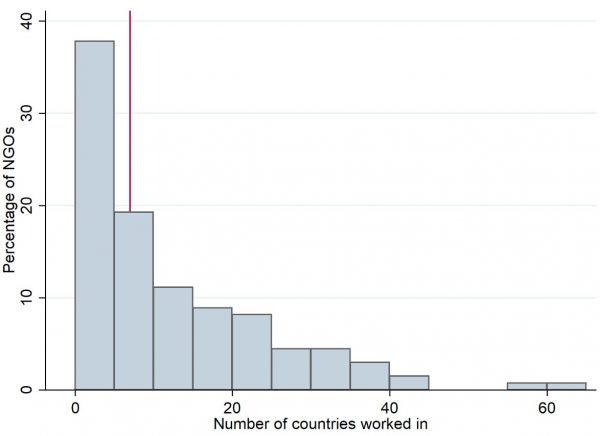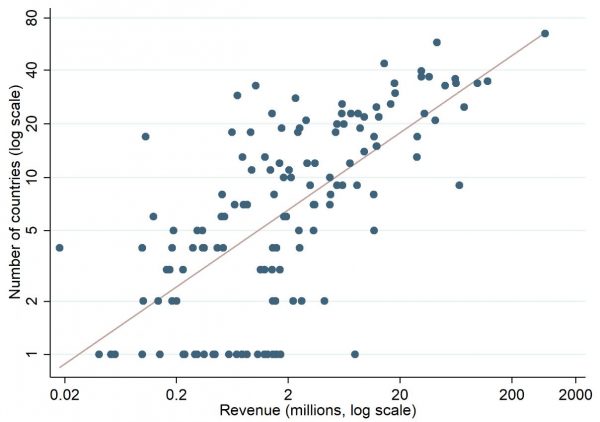In a recent blog I argued that the Australian government gives aid to too many countries. It was an easy post to research. Every year Australia, alongside other OECD government donors, tells the OECD where it spends its aid, and what it spends it on. It’s a very useful transparency tool.
Globally, nothing equivalent exists for NGOs’ aid work. There’s no easy way of learning what most countries’ NGOs do. In Australia, however, thanks to the work of the Australian Council for International Development (ACFID), and the transparency of its members, good data exist on NGOs’ work overseas. The data aren’t completely comprehensive (some NGOs aren’t members of ACFID and some members don’t fully report). However, a large and important subset of the Australian NGO community is covered.
In my recent Devpolicy Discussion Paper, Australian NGOs overseas, I used ACFID data to study where Australian development NGOs work and what they do. One key focus of the report was fragmentation: are Australian NGOs working in too many countries? or in too many sectors? or running too many projects?
In today’s blog I’m going to focus on one type of fragmentation: whether Australian development NGOs spread their work over too many countries. (The other types of fragmentation are covered in the paper itself.) It may be tempting for NGOs to work here, there and everywhere – need is abundant after all. But working across many countries can come at a cost. It may stop NGOs from learning carefully about country contexts or prevent them from forging the enduring partnerships essential to successful aid.
The figure below is a histogram. It shows how many countries the 135 NGOs covered in the study worked in between 2013 and 2018. (Some readers may prefer a fragmentation index. There’s one in Appendix 1 of the paper – it reveals a similar picture.)
Histogram – number of countries Australian NGOs work in
As the histogram shows, most Australian NGOs don’t work in many countries. Nearly 40 per cent worked in five countries or less. (Nearly 20 per cent only work in one country.) The median NGO, shown by the vertical red line, worked in seven countries. Yet, while most NGOs don’t work in many countries, some do: 14 NGOs worked in more than 30 countries; four NGOs worked in more than 40 countries.
It’s a striking difference: most NGOs have a good country focus; others work in a lot of places. There’s an explanation though. Size. You can see this below. NGO size (based on revenue) is plotted on the x-axis. The number of countries NGOs work in is on the y-axis. Each point is an NGO.
NGO country fragmentation versus NGO size
The correlation is clear: larger NGOs tend to work in more countries. It’s a healthy pattern. Larger NGOs have the resources to focus more broadly. Some are also members of international federations, which means they can contribute to existing projects run by other affiliates with appropriate country experience.
All told, the patterns in the figures above look good enough. The typical Australian development NGO doesn’t divide its work across numerous countries. And, usually, the NGOs that work in more countries are larger, and probably better able to do so.
Yet there are still uncertainties. My first uncertainty is simply that I don’t know how many countries is too many. The patterns in the figures above look reasonable to me, but I don’t work for an NGO, and I don’t manage aid projects. More could be learnt, I think, in the future with interviews and surveys of NGO aid workers and managers: what’s their experience of aid fragmentation? Questions could be asked about each of the types of fragmentation covered in my paper, not just country fragmentation. Do NGO staff struggle with projects dotted across different countries? Or spreadeagled over too many sectors? Do they simply find themselves having to manage too many projects?
In the case of country fragmentation, we might learn from interviews that just a few countries is too many. Or we might learn that the role of international federations and local affiliates means fragmentation is easily tolerated.
My second uncertainty stems from the NGOs that buck the trend in the second figure above. In particular, NGOs substantially above the diagonal line of best fit. These are organisations that work in a surprising number of countries for their size. Six NGOs with revenues of less than A$1M worked in more than 10 countries. That seems like too many countries. Of course, numbers can deceive – smaller NGOs working in lots of countries may work well with local partners or in other ways that eliminate issues. This is also true of the other types of fragmentation in the report – outliers often exist, but there may be good explanations. Or there may not. This is a question NGOs need to ask themselves.
Overall, my findings are, I think, positive ones. But they’re not cause for complacency. The sector as a whole could learn more. And some organisations should carefully investigate how they fragment their work. Perhaps they’ll discover all is well. Perhaps though, they’ll learn how they can change, and increase their effectiveness.
This post is the first in a two-part series summarising Devpolicy Discussion Paper 94 Australian NGOs overseas. You can find the second post here.
Disclosure
This research was undertaken with the support of The Bill & Melinda Gates Foundation. The research was also enabled by our ongoing data partnership with the Australian Council for International Development. We are grateful to the ACFID, and to its members for their transparency. The views in the post are those of the author alone.


Leave a Comment